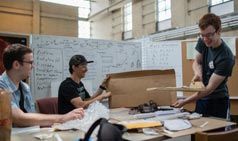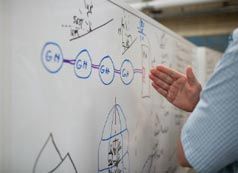It isn't easy to cultivate a garden on Mars.
With an average temperature of minus-80 degrees Fahrenheit, the presence of harmful solar UV radiation, an extremely thin atmosphere, frequent dust storms and meteorite impacts, Mars isn't particularly hospitable to plant life. But in order for a manned mission to Mars to occur in the future, space travelers will need a sustainable food source.
Lehigh engineering students Kevin Augustyn '17, Aidan Din '16 and Aaron Sandoval '17would like to design a greenhouse that can make that possible.
"In order to be most efficient, [astronauts will] need to supply their own food on site instead of sending it from Earth," says Sandoval, a mechanical engineering major also pursuing minors in aerospace engineering and astronomy. "So we need to develop an environment in which we can grow food that will supply adequate nutrition and enough energy for future astronauts."
Staple crops such as wheat, corn, sweet potatoes, lettuce and soybeans tend to thrive here on Earth. But in the extreme conditions of Mars, they would require special accommodations.
"[NASA has] had multiple contests to try to find solutions to this, and they've identified a lot of problems and come up with some solutions but no overall design has been created yet," says Augustyn, a civil engineering major who became interested when he read an article about the problem last year. "[We were] thinking that we could help expand the information available to [NASA] and possibly come up with a solution to the issues they've been having."
Augustyn approached mentors Terry Hart, professor of practice in mechanical engineering and former NASA astronaut, Spencer Quiel, assistant professor of structural, civil and environmental engineering, and Natasha Vermaak, assistant professor of mechanical engineering and mechanics, about a possible Mountaintop project. Augustyn, who would like to someday do structural research for NASA, wrote the proposal for the project, titled "Extra-terrestrial Greenhouses."
"Once they saw what the topic was, we had about 50 students apply," says Hart.
Din and Sandoval were selected from the applicant pool to join Augustyn on the team. Once they got started, Quiel provided guidance in the process of conducting such a large-scale, long-term research project, something none of the students had previously undertaken. Hart, Quiel and Vermaak have provided ongoing support. The project, however, belongs to the students. No one is telling them what to do.
"I'm not sure we know what to do," says Hart with a laugh.
"[The mentors have] definitely played the role of advisors and not necessarily as extra team members, which I think is a good thing in this case," says Din, a materials science engineeringmajor also working on an aerospace engineering minor. "They're there for support if we need them, but they're not here telling us what we should be working on or what we're doing right or what we're doing wrong in the small scale. They're not really trying to micromanage us, but they're still definitely available whenever we have questions."
It didn't take much research for the team to realize the enormity of the problem they were taking on. They decided to narrow their focus to the design of a greenhouse prototype.
"The main challenge of all these materials is that there's a trade-off for the most part, so one thing will perfectly fit a certain parameter but will be worse in another," says Din. "It's kind of a balancing act of trying to find the right material that will work in this application."
The team hopes to then carry their research past the summer, as the project has the potential to become even more interdisciplinary. For now, the students are immersed in an environment that allows them to focus exclusively on the problem they're trying to solve, free from the everyday responsibilities of student life.
"I really like the setup for this research, how we're allowed all the freedom that we have," says Sandoval. "I hope to work at NASA in the future, so working on projects like this is very relevant for my career goals."
"Also," he says, "it sounded pretty awesome."
Read the full story at the Lehigh University News Center.
-Kelly Hochbein is a writer with Lehigh University Media Relations.


